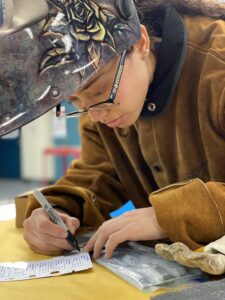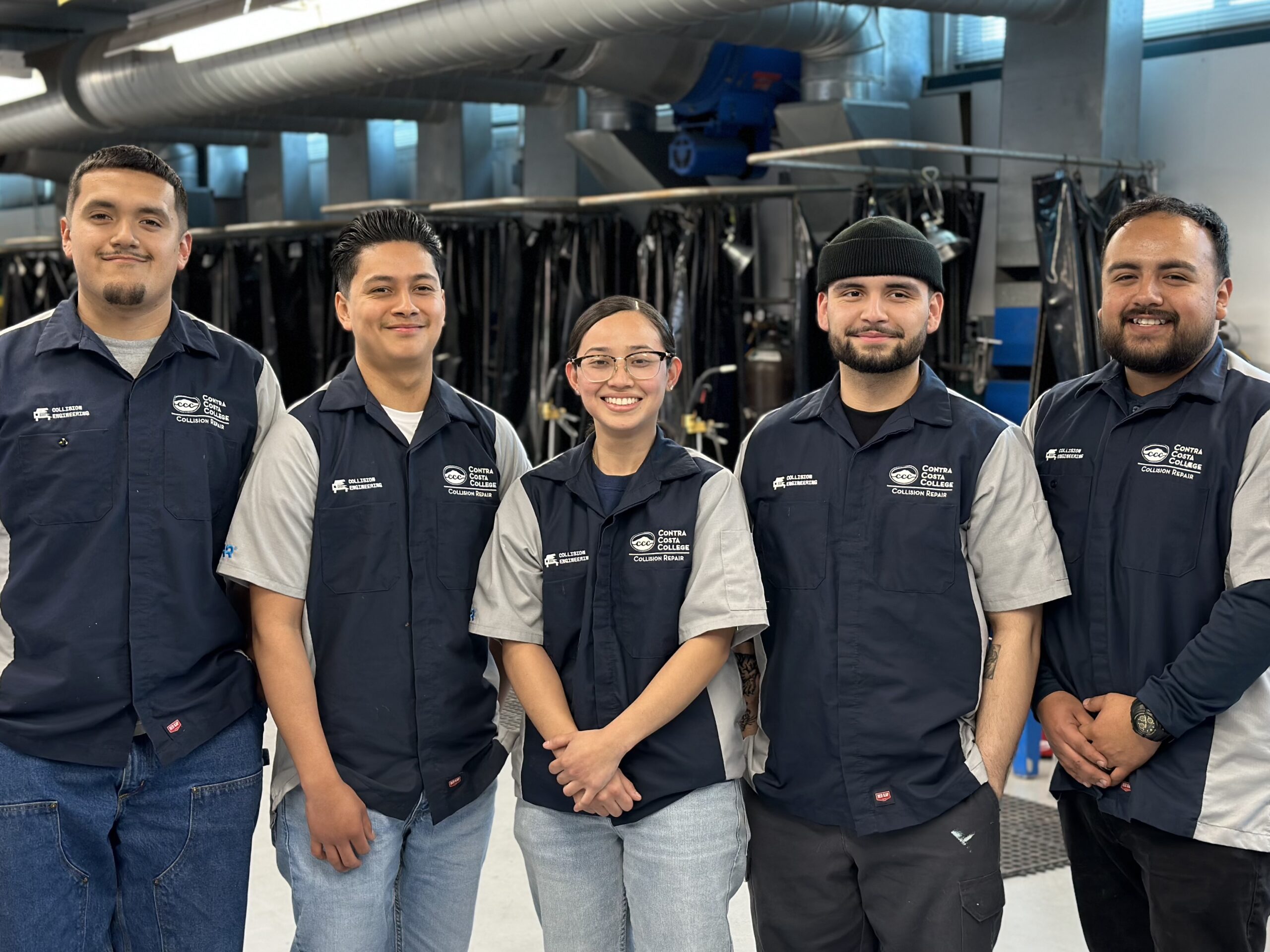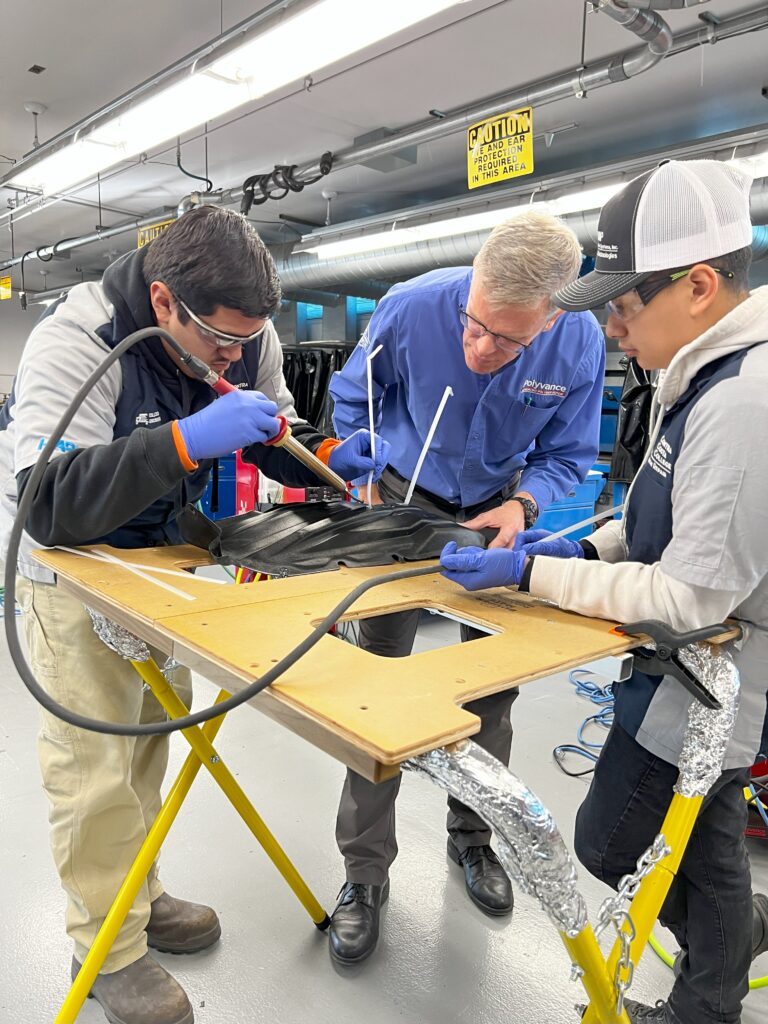
First Contra Costa Collision Engineering graduates: Industry full of opportunity
By onCollision Repair | Education
The first five students in Contra Costa College (CCC)’s Collision Engineering program are set to graduate on Wednesday, marking a huge accomplishment for the school and a bright future for the students.
The Collision Engineering Program (CEP) is a national workforce development program founded by Enterprise Holdings and Ranken Technical College. CCC is one of seven colleges that participate. The program’s two-year apprenticeship model gives students the chance to earn an income while completing their training. Students learn both in traditional classroom settings and by working at modern collision repair shops. Employers can participate in the program through sponsorship.
Repairer Driven News sat down with CCC students Jesse DeLeon, Bryan Ahumada, Cinthia Pool, Sam Ortega, and David Boné to talk about their experience in the program and their plans after graduation. Some just happened upon the program, while others took it on to turn a hobby into a career.
“I decided to join the Collision Engineering Program because I wanted to further my knowledge and education in the automotive industry as well as to work on my own cars,” DeLeon said. “Just out of luck, I ended up in this really great program.
“Growing up, I worked a lot with my Dad who was a diesel mechanic, and then as well as my uncle. This was all throughout middle and high school. So I never really had any real school education or real training when it came to mechanical and vehicle work.”
Ahumada said the program has opened up a lot of opportunities for him and has taught him how to repair vehicles properly.
Cinthia Pool, who wants to eventually be a vehicle engineer, said she joined CEP to expand her knowledge on vehicles, and as a result, has learned what career paths are available for her. “I feel like Collision Engineering has helped me a lot to see where it is that I want to move forward in my career,” she said.
Ortega’s interest in the CEP peaked after learning more about cars through a paint and refinishing class he took to fill in some General Education program credits he needed. As he learned more, he decided to join the CEP. The program is highly competitive, partially due to a need for part-time instructors. At least one, preferably two, is needed and the applicant pool is small, according to Laura Lozano, CCC Automotive Department co-chair and collision repair technology professor.
Boné’s decision to enroll was out of curiosity after working on a couple of cars himself, especially after he took some classes that weren’t right for him.
All five of the soon-to-be graduates plan to stick with the jobs they took as apprentices while in school. They noted working in a real-world shop was incredibly beneficial in not only collision repair skills but also soft skills, like effective communication and working in a team.
“My favorite part of this program was, believe it or not, not actually the program itself but being around other people that have the same mindset as you and just having everybody working on the same thing kind of brings you closer,” Ahumada said. “It brings out a very joyful opportunity here and that’s one of the best things about this program as well. Not just the learning factor but being around other people and having the same goals as them.”
Pool agreed, adding that learning how work environments operate has a lot to do with workplace performance. “My work environment has helped me a lot to feel comfortable working on different projects and asking for help… feeling welcomed.”
Ortega said he loved that “the learning never stops.”
“Everyone will show you different ways of how to do one thing, another thing,” he said. “The knowledge just keeps growing and growing.”
DeLeon enjoyed all the OEM training that are included in the CEP, such as plastic repair, refinishing, and welding. “I was able to learn in-depth on why it’s important to do those things the way that they tell you to do it. Not just only doing it because it says so, you learn why.”
The CEP and shops that participate in the apprenticeships through CCC’s CEP having the same vision was Boné’s favorite part of school.
“Where I’m working at right now, I feel like I would have never been able to work there if it wasn’t for this program,” he said.
When asked what advice they’d give to middle school and high school students that are considering a career in the collision repair industry, all five said it’s a great industry to get into with many career opportunities but it takes a lot of work.
Ahumada noted good money can be made in the industry but it’s also “an enjoyable time and you do meet a lot of nice people in this industry.”
Being a technician isn’t the only option, Pool and DeLeon noted. Just to name a few, there’s an estimator, shop owner, or distributor, DeLeon said.
“It opens up many doors for you and you meet so many people who will help you network throughout the way, so you have support in this industry as well,” Pool said.
Ortega encourages young students to have an open mind about pursuing the trade. “If you truly want to do it then go for it but it’s not always going to be so easy so they’ve also got to think about that.”
Boné added that anyone thinking about joining the industry needs to consider how hands-on it is and that “there’s going to be hard times and there’s going to be easy times.”
“That shouldn’t be the reason why you don’t go and shoot for what you want,” he said. “At the end of the day, it’s going to be up to you… it doesn’t matter what industry you’re in. Just don’t be discouraged. Keep on pushing yourself.”
Boné was hired for his apprenticeship at Barsotti’s Body & Fender. Shop manager Amber Alley told RDN the Collision Engineering program really helps connect the dots between education and working in the field. A second Contra Costa Collision Engineering student was also recently hired on at Barsotti’s.
“We have these semester meetings about where they’re at and what they’re learning in school, so we can obviously support that in shops,” Alley said. “For example, they’re going to be working on welding and she’s [Lozano] got the I-CAR welding setup. She’s going to be in this education setting reviewing that then we can also make sure he has those opportunities to apply that in shop.
“I definitely think the school, this relationship with Collision Engineering, has made me a better manager of the process of training. And it’s also inspired my technicians. They used to have this attitude in the shop of, ‘You want me to train someone? I worked hard for all the knowledge, you just want me to give it away?’ I think with David, I’ve actually had some of the more senior techs say, ‘Hey, if you want to hire an apprentice, I wouldn’t mind teaching them.”
So what are these graduates’ ultimate goals? For Ahumada and Ortega, it’s to build a car from the ground up. Ahumada plans to document every step from beginning to end then take it to car shows to show off his work.
DeLeon said he wants to venture into the business side of the automotive industry by owning his own distribution company or body shop.
Boné’s plan is to help others of all ages by teaching collision engineering skills.
“In the industry, you get to see a lot of technicians that don’t have the same information, the training… The industry is really big — it looks very small, it looks like your typical shop — but there’s so many other things that they can learn and there’s still so much opportunity there.”
When students join CCC’s CEP program, they have the option to take the Collision Engineering route, which includes an internship in industry while they’re in school. By week nine of their first semester, each student is tasked with finding a job, if they don’t already have one in the collision repair field. The first eight weeks is classroom learning followed by lab hours in shops under the mentorship of a technician for the next eight weeks.
Trade school enrollment ‘booming’
Amid an ongoing skilled trades worker shortage — including collision repair, automotive, and diesel technicians — The Associated Press reports that enrollment is up as more students are seeking certificates and other short-term credentials.
Trade programs are often more affordable than a traditional four-year degree, students note, and, for many, skilled trades offer a more obvious path to a job, the AP wrote.
During the fall 2022 semester, enrollment in mechanic and repair technician programs nationwide grew by nearly 99,000 students, or 5.4%, following a 4% increase in 2021, according to the National Student Clearinghouse Research Center. Enrollment was down 14.9% in 2020, partially due to the COVID-19 pandemic.
Overall enrollment declined 1.8% at public two-year colleges and 3.4% at public four-year institutions.
Many in the industry say the key to addressing the shortage is to work together. Lozano and CCC have found that the CEP has bridged the gap between education and employment expectations for students.
“In this last two-and-a-half, three years with this first round of students, we have learned so many things in regards to the level of resources that it takes on both sides, both industry and education, to create this level of a graduate, of a technician,” Lozano said. “We’ve learned a lot in terms of the amount and different types of communication that are most efficient in this process between education and industry.
“For a long time, at least our experience locally has been from the industry side, ‘There aren’t any students. There aren’t any qualified entry-level technicians.’ And on the education side, the communication used to be, ‘Well, industry brings them in and chews them out. The industry doesn’t know how to take care of our students.’ Now, what collision engineering has done and it’s, it’s bridged the gap of communication and expectation between both education and industry.”
Now that CCC and the industry see eye to eye, she said, students are met where they’re at and helped through a two-year curriculum to graduate above entry-level technician skills.
Images
Featured image: Contra Costa College (CCC) Collision Engineering Program (CEP) student Cinthia Pool works during an I-CAR welding course. (Credit: CCC)
CCC CEP students Jesse DeLeon, David Boné, Cinthia Pool, Sam Ortega, and Bryan Ahumada. (Credit: CCC)
CCC CEP students Jesse DeLeon and David Boné work during a Polyvance plastics repair course. (Credit: CCC)
More information
Apprenticeship program to train aspiring auto techs expands to seventh school
Tech shortage ‘the cancer eating away’ at industry’s bottom line
More young adults are pursuing trades instead of college, statistics indicate


